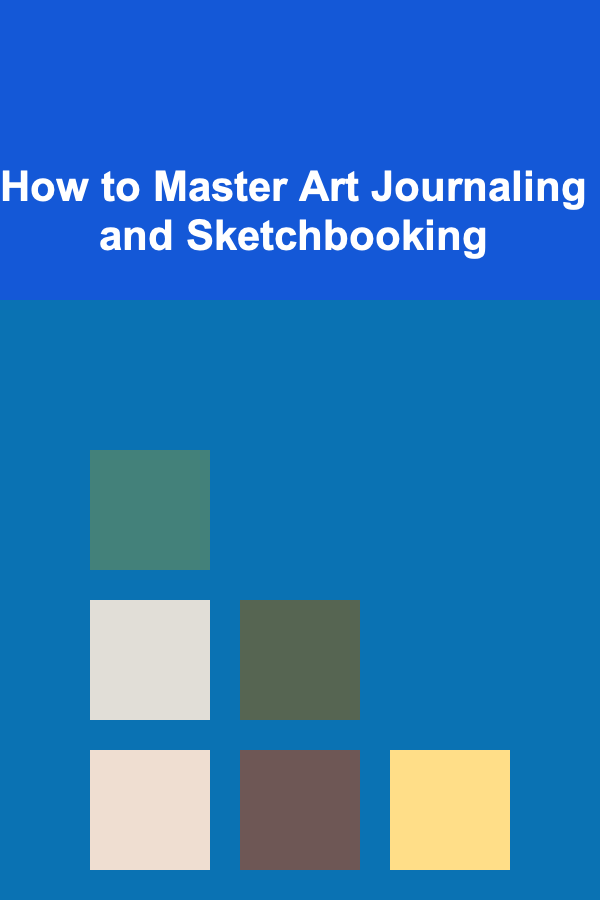
How to Master Art Journaling and Sketchbooking
ebook include PDF & Audio bundle (Micro Guide)
$12.99$8.99
Limited Time Offer! Order within the next:

Art journaling and sketchbooking are powerful practices that allow individuals to express their creativity, explore their emotions, and develop their artistic skills. Whether you're a seasoned artist or a beginner, these practices offer an open and personal space for experimentation, self-reflection, and growth. In this article, we'll dive deep into the world of art journaling and sketchbooking, providing you with valuable insights on how to master these forms of creative expression.
Understanding Art Journaling and Sketchbooking
What is Art Journaling?
Art journaling is a form of personal expression that combines art with journaling. It involves creating visual content in a journal, often using a variety of mediums, such as paint, pens, stamps, and collage, alongside written elements. The key difference between art journaling and traditional journaling is the use of imagery and visual elements to complement the written word, creating a more immersive and multi-dimensional experience.
The purpose of art journaling is not necessarily to create polished artwork, but rather to capture feelings, memories, and ideas. It is about freedom of expression and can serve as a therapeutic outlet for emotions, thoughts, and experiences.
What is Sketchbooking?
Sketchbooking, on the other hand, is primarily about drawing. A sketchbook is a place where artists, both beginners and professionals, can practice sketching, drawing, and experimenting with various techniques. It often serves as a visual diary, recording ideas, concepts, and observations. While it may include written notes or annotations, the primary focus is on drawing and visual representation.
Sketchbooks can be filled with quick sketches, detailed studies, rough ideas, or even fully realized pieces of art. For many artists, their sketchbook is an essential tool for developing ideas that will later be turned into finished works of art.
The Benefits of Art Journaling and Sketchbooking
Personal Expression
Art journaling and sketchbooking provide a space for deep personal expression. Through images, colors, and words, you can explore complex emotions, experiences, and ideas that may be difficult to articulate with language alone. These practices allow you to connect with your inner self and express what's happening in your mind, body, and spirit.
Creativity Boost
Both art journaling and sketchbooking are fantastic ways to boost creativity. They provide a low-pressure environment where you can freely explore new ideas and experiment with different techniques. The very nature of these practices encourages risk-taking, which can lead to new discoveries and innovations in your artistic journey.
Stress Relief and Mindfulness
Engaging in art journaling or sketchbooking can be a highly therapeutic practice. The act of drawing or creating without the need for perfection can be incredibly relaxing. It allows you to be present in the moment, reducing stress and helping you to focus on the here and now. Many people use these practices to unwind after a long day, find clarity in their thoughts, or process emotions in a safe and creative way.
Skill Development
Both art journaling and sketchbooking offer an excellent platform for improving your artistic skills. Whether you're a beginner looking to practice basic techniques or an experienced artist aiming to develop your style, these practices allow for continuous improvement. You can experiment with different mediums, styles, and approaches, gradually refining your abilities over time.
Getting Started: Essential Tools and Materials
To start your journey in art journaling and sketchbooking, you'll need some basic tools and materials. The beauty of these practices lies in their accessibility---there's no need for expensive supplies to begin.
Choosing the Right Journal or Sketchbook
Your journal or sketchbook is the foundation of your art practice. Here are some factors to consider when choosing one:
- Size: Consider what size is comfortable for you. Smaller sketchbooks are portable and convenient for quick sketches on the go, while larger ones provide more space to create detailed artwork.
- Paper Quality: The type of paper is important, especially if you plan to use wet media (such as watercolor or acrylic paint). Look for thick, high-quality paper that can handle different materials without warping or tearing.
- Binding: Some people prefer spiral-bound sketchbooks because they lay flat, while others prefer bound journals for a more cohesive, book-like experience. The choice is entirely personal.
Essential Art Supplies
When it comes to supplies, there's no need to buy everything all at once. Start simple and gradually add more tools as you become more comfortable. Here's a basic list of materials for both art journaling and sketchbooking:
- Pens and Markers: Choose a selection of pens with different tip sizes for line drawing, outlining, and journaling. Gel pens, fine liners, and permanent markers work well for creating clean lines and writing.
- Pencils: A range of pencils from H to B (hard to soft) will give you versatility for sketching. Use H pencils for light lines and fine details, and B pencils for shading and darker lines.
- Watercolors: If you want to introduce color into your journal or sketchbook, watercolors are a great option. They're easy to work with and blend well on paper.
- Collage Materials: If you're into mixed media art journaling, consider adding materials like magazine clippings, patterned paper, and fabric. These elements add texture and dimension to your journal pages.
- Stamps and Stencils: Stamps can help create repeat patterns or shapes, and stencils can assist with creating precise designs. Both tools are excellent for adding layers of interest to your work.
Optional Tools
As you develop your practice, you might want to explore other tools, such as:
- Acrylic Paints: Great for bold, opaque color.
- Ink and Brushes: Perfect for creating expressive, fluid lines.
- Pastels or Charcoal: Ideal for adding depth and texture to your artwork.
Techniques to Master in Art Journaling and Sketchbooking
Now that you have your materials, let's explore some techniques to help you make the most of your art journaling and sketchbooking experience.
1. Layering and Collage
One of the key techniques in art journaling is layering. This involves building up layers of materials to create depth and texture. Start by adding a base layer, such as a painted background or collage, and then add subsequent layers of imagery, text, or drawings. Each layer contributes to the overall composition, adding complexity and visual interest.
Collage is a popular technique in art journaling. You can cut out images or words from magazines, old books, or newspapers and glue them into your journal. This method is great for adding meaning and storytelling elements to your pages.
2. Doodling and Drawing
Doodling is a fantastic way to express yourself while also practicing your drawing skills. Start with simple lines and shapes, and gradually build on them to create intricate designs. You can experiment with different styles, such as geometric patterns, organic shapes, or even abstract art.
In your sketchbook, focus on practice rather than perfection. Use it as a space to sketch daily or as often as you like. The more you practice, the more confident you'll become in your drawing abilities.
3. Watercolor Washes and Painting
Watercolor is a versatile medium that works well in both art journaling and sketchbooking. You can create soft washes of color to add background depth or vibrant splashes to highlight specific areas. Experiment with different techniques, such as wet-on-wet (where wet paint is applied to wet paper) or dry-brush (where paint is applied with a dry brush for a textured effect).
Remember that watercolor doesn't need to be controlled; embracing its fluid nature can lead to stunning, unpredictable results. Let the paint do its thing, and enjoy the process.
4. Typography and Hand-Lettering
Incorporating handwritten text into your art journal or sketchbook adds a personal touch and can enhance the storytelling aspect of your work. Try out different styles of handwriting, calligraphy, or hand-lettering to create dynamic compositions. Use your words to express thoughts, emotions, or even poetry.
5. Creating Atmosphere with Color
Color plays a huge role in setting the mood of your art journal or sketchbook page. Experiment with different color palettes, keeping in mind how colors can evoke emotions. For example, warm tones like reds, oranges, and yellows create energy and warmth, while cool tones like blues and greens bring a sense of calm and tranquility.
Incorporate contrasting colors for visual interest or use analogous colors (colors that are next to each other on the color wheel) for a harmonious effect.
Overcoming Common Challenges
Perfectionism
Many beginners struggle with perfectionism in their art journals and sketchbooks. Remember that the beauty of these practices lies in their freedom. Don't be afraid to make mistakes, and embrace the idea of imperfection. The more you let go of expectations, the more enjoyable and authentic the experience will become.
Creative Block
If you're feeling stuck or uninspired, try giving yourself small prompts or challenges. For example, you could focus on a specific theme (such as nature or emotions), limit yourself to a single medium (like watercolor or pencil), or simply start with a random doodle to get your creativity flowing. The key is to keep going, even if it's just for a few minutes each day.
Fear of Judgment
Art journaling and sketchbooking are deeply personal practices, and it's natural to feel vulnerable about sharing your work. However, these spaces are meant to be private, and they're for you alone. Don't worry about what others might think---focus on your own creative process and the joy it brings you.
Conclusion
Mastering art journaling and sketchbooking is a journey of personal expression, creativity, and skill development. It's not about creating a perfect product, but rather about embracing the process of creation itself. By experimenting with different techniques, materials, and approaches, you can develop your own unique style and create meaningful works that reflect your inner world.
Remember that the most important aspect of art journaling and sketchbooking is to enjoy the process. Let go of expectations, embrace mistakes, and allow your creativity to flow freely. Whether you're using these practices for personal reflection, artistic growth, or just as a way to relax, they can be incredibly rewarding and transformative. Happy creating!

How to Budget for Weddings and Family Celebrations
Read More
How to Cut Back on Impulse Purchases for Your Home
Read More
How to Host a Wine and Cheese Tasting Party at Home
Read More
How to Find Hidden Savings
Read More
How to Detect and Avoid Loaded Dice
Read More
How to Curate a Vintage Fashion Collection
Read MoreOther Products

How to Budget for Weddings and Family Celebrations
Read More
How to Cut Back on Impulse Purchases for Your Home
Read More
How to Host a Wine and Cheese Tasting Party at Home
Read More
How to Find Hidden Savings
Read More
How to Detect and Avoid Loaded Dice
Read More